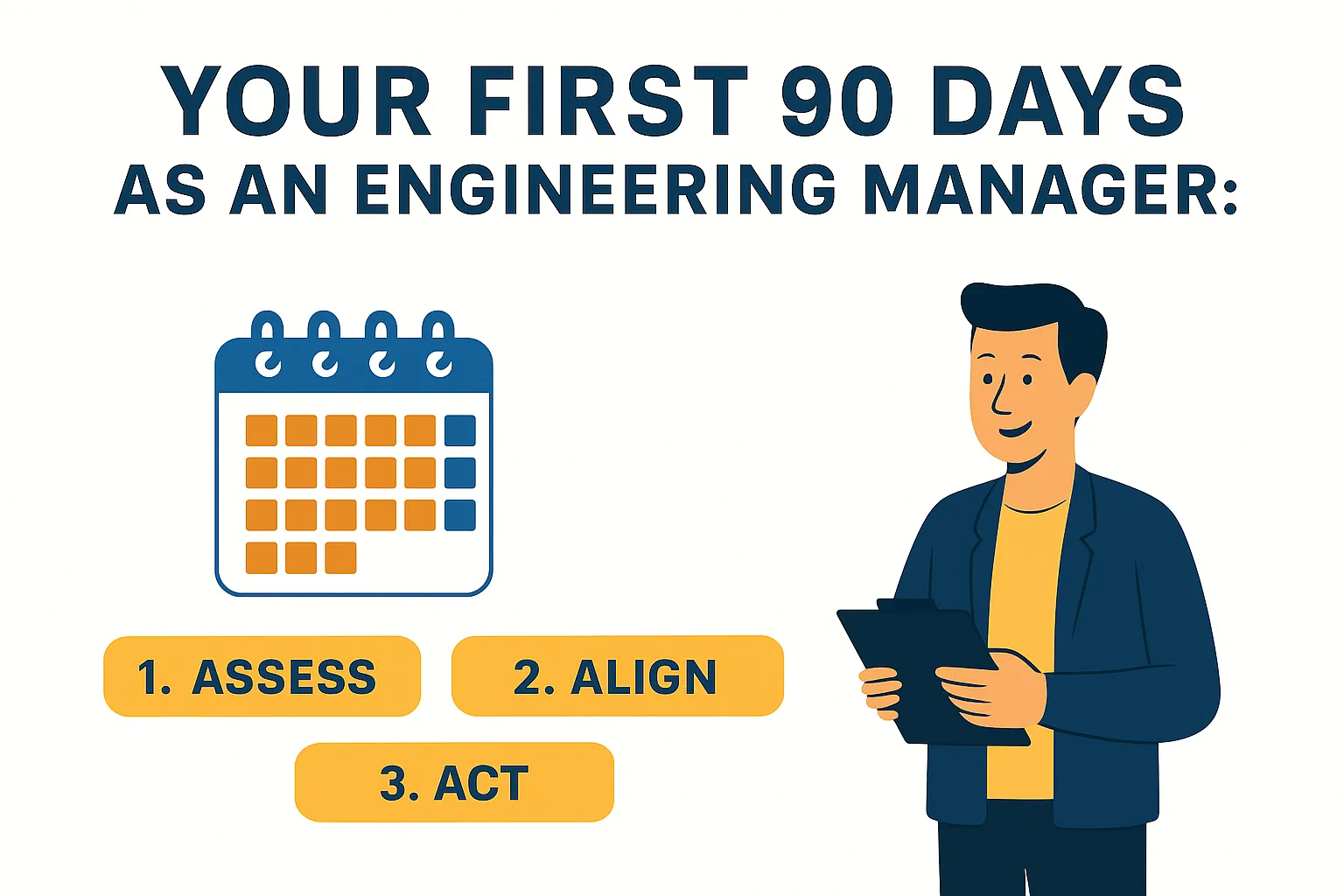06. First 90 Days as an Engineering Manager

Transitioning into an Engineering Manager (EM) role is one of the most rewarding - and most disorienting - shifts in a software engineer’s career. Suddenly, your success is no longer measured by the code you write but by the impact you enable through others, I wrote whole blog blog post about it: From Individual Contributor to Engineering Leader: Navigating the Mental Shift. You might wonder: Where do I even start?
This post gives you a structured, week-by-week breakdown of how to approach your first 90 days as an EM - whether you’re promoted internally or joining a new company.
Phase 1: Weeks 1-2 - Listen, Learn, and Observe
Objective: Build context, not authority
Your first instinct might be to add value by fixing broken processes or making suggestions. Resist that. In your first two weeks, your focus should be on listening, not leading. Start with humility and curiosity.
What to do:
- Introduce yourself! - let people know you, talk about your core values and what is important for you. (Read my related post How New Engineering Managers Should Introduce Themselves )
- Meet everyone 1:1 - not just your direct reports, but also peers (product, design, QA) and your own manager.
- Ask open questions, such as:
- What’s working well?
- What frustrates you?
- What should I know about this team’s history?
- Read everything - past retrospectives, OKRs, onboarding docs, Slack history.
- Observe rituals - Standups, sprint reviews, tech huddles. Just watch for now.
Watch out for:
- The temptation to immediately “fix” something.
- Making promises before you understand the system.
Phase 2: Weeks 3-4 - Map the Terrain
Objective: Understand the system and your leverage points
Now that you’ve listened, it’s time to synthesize what you’ve heard and start drawing a mental map of your team and the surrounding ecosystem.
What to do:
- Build a team map:
- Who are your top performers?
- Who’s at risk of burnout?
- Who’s disengaged?
- Understand your team’s mission:
- Is it clear?
- Does the team understand how their work contributes to business goals?
- Audit processes:
- Are ceremonies effective or just rituals?
- Is tech debt slowing velocity?
- Talk to stakeholders - especially Product and Design - about alignment, friction, and expectations.
Tools to use:
- A “Team competency matrix” - Identify what if team have needed skills.
- A “Team health” matrix (can be as simple as sticky notes on a Miro board).
- Lightweight retros with small subgroups to test psychological safety.
Phase 3: Month 2 - Establish Trust and Team Rituals
Objective: Begin influencing through trust and small improvements
By now you’ve built relationships and gathered data. It’s time to start making lightweight adjustments - not by imposing change, but by co-creating improvements with your team.
What to do:
- Standardize 1:1s:
- Make them weekly or biweekly.
- Use a shared doc (Shared Online Excel, Google Docs, Notion) to track topics.
- Make space for career development, not just status updates.
- Introduce one or two small wins:
- Reduce unnecessary meetings.
- Clarify how bugs are triaged.
- Improve visibility into delivery status.
- Co-create a Team Operating Manual:
- How do we communicate?
- What are our shared values?
- How do we handle outages, reviews, design?
Pro tip:
If you make one meaningful improvement - and credit the team for it - you build massive trust.
Phase 4: Month 3 - Lead with Intent, Not Control
Objective: Establish your leadership presence and long-term vision
Now that you’re trusted, visible, and informed, it’s time to look forward. Your job is to set direction, inspire growth, and enable autonomy - not to be the smartest person in the room.
What to do:
- Facilitate a retrospective about your first 90 days:
- What’s better now?
- What do we still need to work on?
- Set development goals with your reports:
- Use frameworks like grow, stretch, or career ladders.
- Make growth visible and measurable.
- Start delegating:
- Let engineers lead initiatives.
- Assign ownership for rituals like standups or tech talks.
- Collaborate with leadership on medium- and long-term strategy:
- Headcount planning
- Architecture investments
- Scaling practices
A Mindset Shift to Embrace
The biggest challenge in your first 90 days won’t be tactical - it’ll be psychological.
You’re no longer rewarded for solving the problem yourself. Your impact comes from enabling others to do great work, even if it means you’re no longer writing code every day. That doesn’t make you less technical - it makes you more strategic.
Leadership is a multiplier role. More about it you can read in dedicated post: From Individual Contributor to Engineering Leader: Navigating the Mental Shift
Summary Checklist
Here’s a distilled checklist for your first 90 days:
Weeks 1-2:
- Introduce yourself
- 1:1s with team and peers
- Read past docs, rituals, Slack threads
- Listen and build trust
Weeks 3-4:
- Identify team health and dynamics
- Map ownership, blockers, and strengths
- Talk to cross-functional stakeholders
Month 2:
- Run effective 1:1s
- Deliver small wins
- Co-create team norms
Month 3:
- Run retro on your first 90 days
- Set career goals with each team member
- Start delegating responsibilities
- Shape long-term vision with leadership
Final Thoughts
Your first 90 days as an Engineering Manager are about building credibility, creating psychological safety, and learning how to lead through others. You don’t need to have all the answers - you just need to build the kind of team that can find them together.